35 Japanese Foods, Dishes, and Meals To Try

Are you wondering what to eat in Japan and what the best Japanese foods are? We’ve been back to Japan numerous times, and while the culture, people, and scenery are fantastic, all the popular Japanese dishes keep bringing us back!
Japanese foods don’t just taste good, but it’s the whole presentation and service that adds to the dining experience. Japan has world-class service and world-renowned food to try. Even if you’re a picky eater when you travel, I guarantee you will be able to find some Japanese dishes you will like.
The Japanese take their food very seriously, with some top chefs dedicating their lives to creating the country’s best food. Whether it’s your first trip to Japan or your tenth, there’s always a new must-try food item you haven’t yet tasted.
Popular Japanese Foods to Try
Sushi

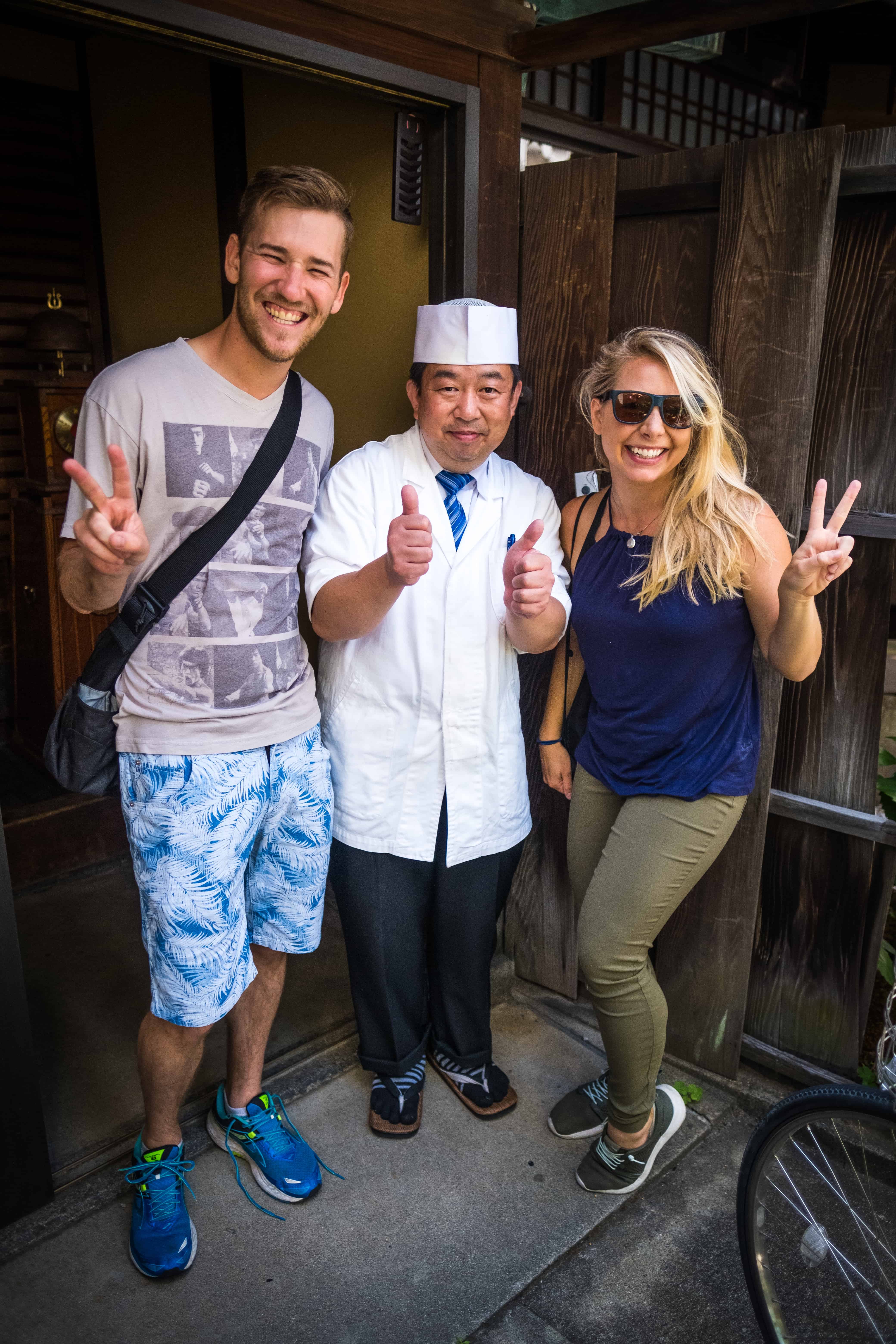
You probably know sushi originated from Japan and is the most well-known food. However, you will not find any Dragon Rolls, California Rolls, sweet sauces, spicy tuna, or fancy creations popular in Western culture. The idea of the uramaki (inside out) roll actually originated in Vancouver!
The word sushi refers to any dish made with Japanese rice seasoned with rice vinegar. There are many different types of sushi in Japan. Maki sushi rice and filling rolled in nori seaweed and Nigiri sushi rice with fish over the top, typically served with wasabi between two, are the two most common types.
You can’t go to Japan and not have sushi; it’s a must-try food. Read your reviews and scope out an excellent sushi restaurant wherever you are. Also, if you love it as much as we do, consider taking a sushi-making course!
Conveyor Belt Sushi

If you are curious about an extremely popular Japanese food, let me introduce conveyor belt sushi. I felt that I had to differentiate sushi from conveyor belt sushi because they are very different experiences. A traditional restaurant for sushi prides itself on the utmost quality, presentation, and service. However, a conveyor belt sushi is all about convenience, and it’s extremely popular.
Conveyor belt sushi is a quick and cheap meal in Japan. Sushi is made and sent out onto a train like a conveyor belt, which rotates around the restaurant. Guests can grab what they please, and then at the end of the meal, the waitress will tally up the plates to give a total for the meal.
The plates are different colors, and the higher-grade sushi is served on more expensive dishes, which are all color-coded. Typically, you can get two pieces of nigiri for ¥100 to ¥200, and the prices go up depending on the fish cut. You can easily walk out of a sushi conveyor belt meal feeling stuffed with high-quality fish for under ¥1000. That’s the price of bad/mediocre sushi in the United States!
Approximate Cost: ¥1000 pp (¥150-¥250 per plate)
Ramen

Japanese Ramen is a noodle soup dish made with wheat noodles, broth, and different toppings. It is one of the most popular traditional foods and a must-eat. The broth is usually soy, miso, pork, or salt, and you can pick and choose what you want at many restaurants.
However, many Ramen shops typically have a specific broth they consider their specialty. Much of this comes down to Kodawari, which refers to the Japanese pursuit of perfection. The idea of pursuing perfection can be seen throughout their culture, including the humble ramen bowl.
Ramen toppings include various variations of meat, vegetables, nori, and bamboo shoots. The most common meat I find in ramen is pork, but vegetarian options are also possible. Ramen is one of the cheapest meals in Japan, and it can be found almost anywhere. It’s an everyday meal that locals and foreigners LOVE. Japanese ramen is a quick and easy meal that is great to have in the winter when trying to warm up.
Don’t be surprised if you find a machine in many ramen shops. Here, you will order your ramen, pay at the machine, and give your choice to the ramen chef. Often, everything is in Japanese – so prepare for an adventure!
Approximate Cost: ¥600-800 a bowl
Udon

Another fantastic Japanese dish to try is Udon. Udon noodles are made from wheat flour and brine water and are usually very thick and mildly chewy. A Udon meal is substantial and can be served hot or cold, making it a tremendous Japanese food for any time of year.
Udon can be served as a soup or with just the noodles and a side sauce for dipping. My favorite way to eat Udon is as a soup. Udon soup can come with different toppings like tempura shrimp, vegetables, or tofu – it’s all to your liking! Udon noodles are also very cheap to buy at the grocery store, so you can make them yourself!
Approximate costs: ¥750-1250 a meal
Soba
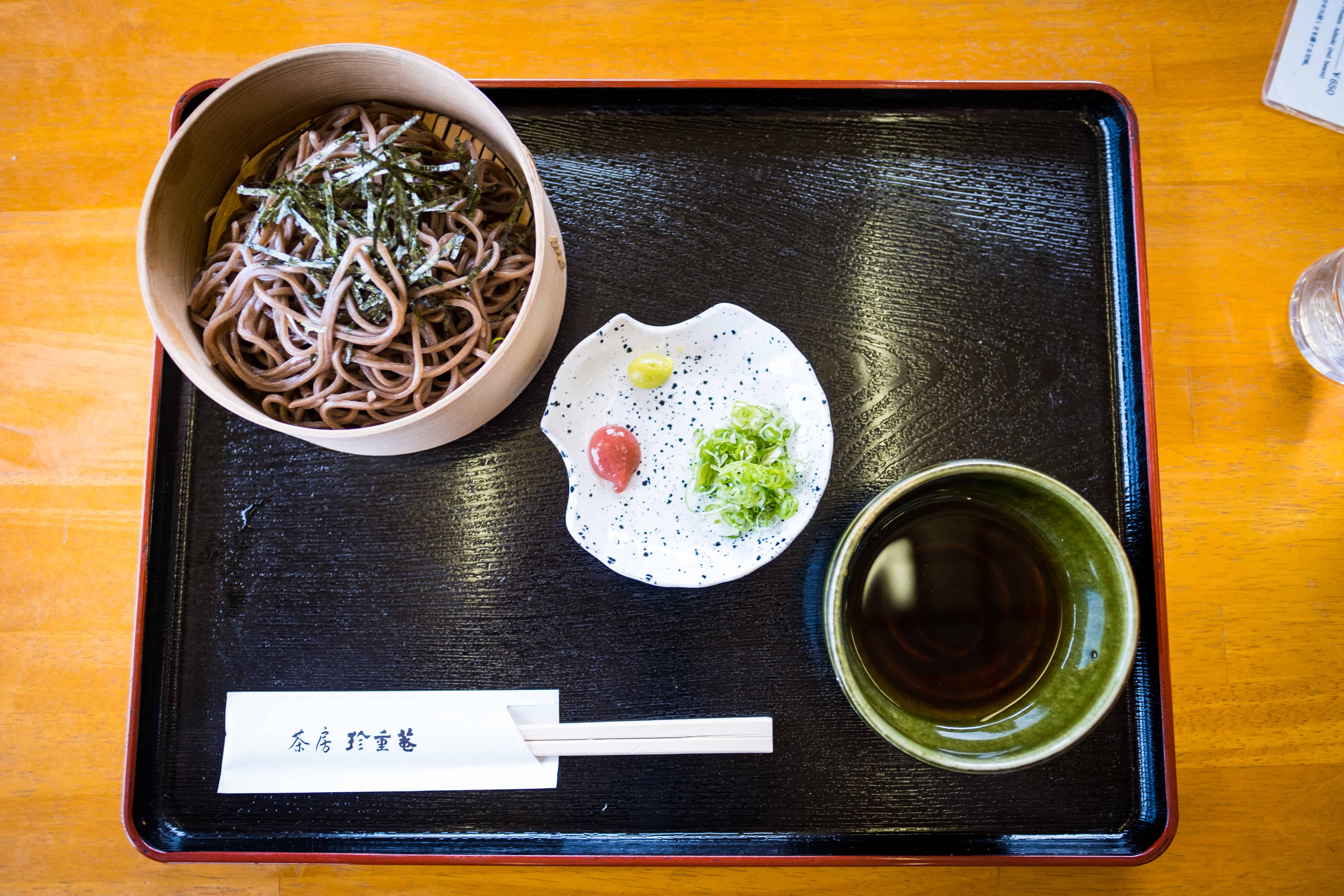
We are not done with Japanese noodle dishes quite yet! Soba is the Japanese word for buckwheat, and that’s exactly what soba is—buckwheat noodles. The buckwheat flour gives soba noodles a distinct and robust taste. Soba noodles are thin, brown, or gray-colored noodles made from buckwheat flour, wheat flour, and water.
They are a traditional Japanese food often served cold with dipping sauce or in a hot broth as a noodle soup. Often, there is a side of tempura flakes, green onions, or wasabi. They can also be stir-fried or added to salads. Soba noodles are a good protein source and a healthier alternative to traditional wheat noodles. We love them the most traditional way which is cold.
Approximate Cost: ¥1000+ pp
Yakitori

Yakitori is a Japanese skewered chicken typically skewered on a steel or bamboo skewer and is one of the most popular Japanese foods to try. The chicken is then grilled over a charcoal fire and served to guests steaming hot. It’s not just your regular chicken breast, either. Yakitori may involve chicken meatballs, gizzards, hearts, wings, feet, thighs, and tails, or if you’re brave, you can try the small intestines.
It’s a popular style of restaurant in Japan, and they’re synonymous with drinking. They’re often lively environments where Japanese come to eat and drink with friends, family, and colleagues. In the Yakitori restaurants we’ve been into, we’ve always been able to order sides of vegetables (like edamame), too.
Approximate Cost: ¥300 per skewer
Genghis Khan

Genghis Khan (Mongolian barbecue) is a local Hokkaido dish that consists of grilling mutton and vegetables on a unique grill with a raised mound in the center. It’s pretty similar to Yakitori and Korean BBQ, and the name comes from how the grill resembles a Mongol helmet. The most popular place to try Genghis Khan is in Sapporo, and locals regard it as soul food. Genghis Khan usually involves several rounds of beer to wash down all the flavors.
Genghis Khan is served tapas-style, and you can order as much as you like on an ongoing basis. You will also receive a side of delicious sauce to dip your meat and vegetables in. At the end of the meal, it is very common to drink that side of sauce, signifying you are done and satisfied.
Approximate Cost: ¥4000+ pp
Okonomiyaki

Okonomiyaki can only best be described as a Japanese pancake or pizza. It’s an important part of Japanese cuisine and is beloved by many. The first time I had one, I loved the presentation and the taste! This traditional Japanese food is made by mixing cabbage, batter, some vegetables, and your choice of protein. Then it is topped with all kinds of sweet sauces.
It is a staple food to try in Japan and can be found around the country. Okonomi means “as you like it,” and yaki means “grilled,” so it’s a meal catering to your preferences. Okonomiyaki is said to originate from Osaka, so having it in the city is a must. We scoured Dotonbori for the best Okonomiyaki in Osaka and landed on Creo-Ru Takoyaki & Okonomiyaki. Depending on the type of Okonomiyaki you order, you can expect to pay between ¥700 to ¥1300 for one pancake. However, we found one was more than enough for two to share.
Approximate Cost: ¥700-1300 per pancake
Takoyaki


Takoyaki is a ball-shaped Japanese snack made from wheat flour batter filled with minced or diced octopus. The ball is fried in a specialty pan and then topped with takoyaki sauce, mayonnaise, bonito flakes, pickled ginger, and green onions.
It’s a sweet and savory snack that will fill you up at least a little bit. It became popular in Osaka in the mid-1930s, and nowadays, you will see street vendors selling Takoyaki down Dotonbori Street. The famous place to try Takoyaki is Aizuya, which is recommended in the Michelin guidebooks.
Approximate Cost: ¥500-800 pp
Japanese Curry
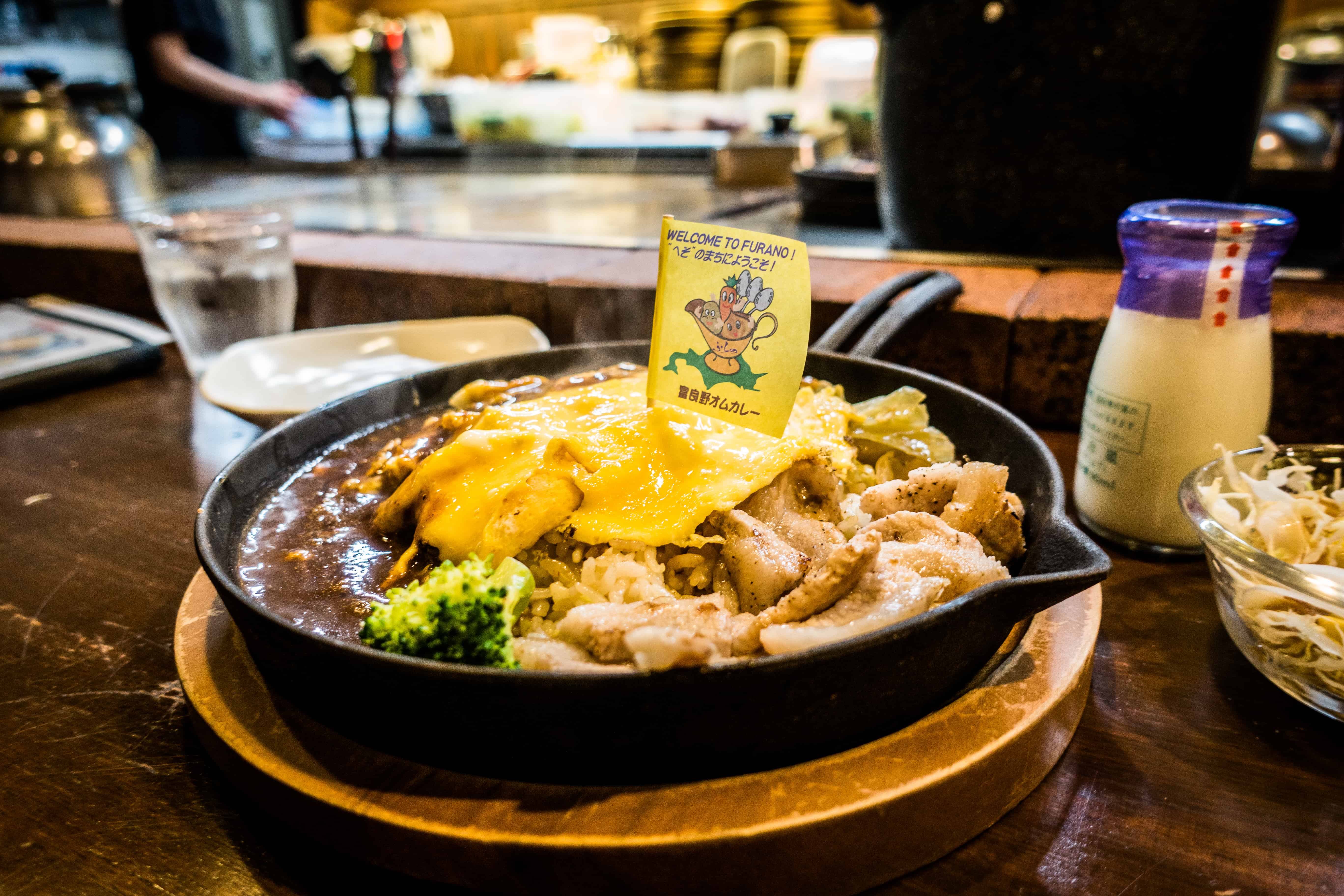
You’ve likely had Indian curry before, but have you tried delicious Japanese curry? Curry is one of Cam’s favorite meals in the country, and it’s one of the most popular Japanese meals, especially in winter! Japanese curry involves different vegetables and either meat, pork, or chicken. The meat is breaded, deep-fried (Katsu-kare), and then topped with curry sauce.

I never found the curry sauce crazy spicy, but it’s not mild. Japanese curry can be served over rice (curry rice), noodles (curry udon), or a curry-filled pastry (curry bread). It’s also super popular to have the curry with an omelet, which is an affordable meal. We had one of the best curries of our life in Furano, on a cold snowy day!
Approximate Cost: ¥700-1300 pp
Kobe Beef

Kobe Beef is the crème de la crème of beef. It is from the Tajima strain of Japanese Black cattle raised in Hyogo Prefecture of Japan and must meet strict standards for marbling, color, texture, and taste. The highest rating is A5, and the demand is huge so prices are sky-high for the top-tier cut. The real stuff is decadent, as the fat content/marbling is so high, so a small portion more than satisfies the appetite.
Expect to pay at least ¥ 8,000 for a small portion of Kobe Beef in Japan; anything less is likely not the real deal. The price of Kobe beef varies depending on the cut of meat, the grade, and the location where it is sold. Do your research if you want the real Kobe beef. My first time traveling to Japan I walked into the first restaurant advertising in the city of Kobe, I paid ¥2000 for the entire meal set. Was it delicious? Sure was. Was it real? No.
Approximate Cost: ¥8000+ pp
Sashimi
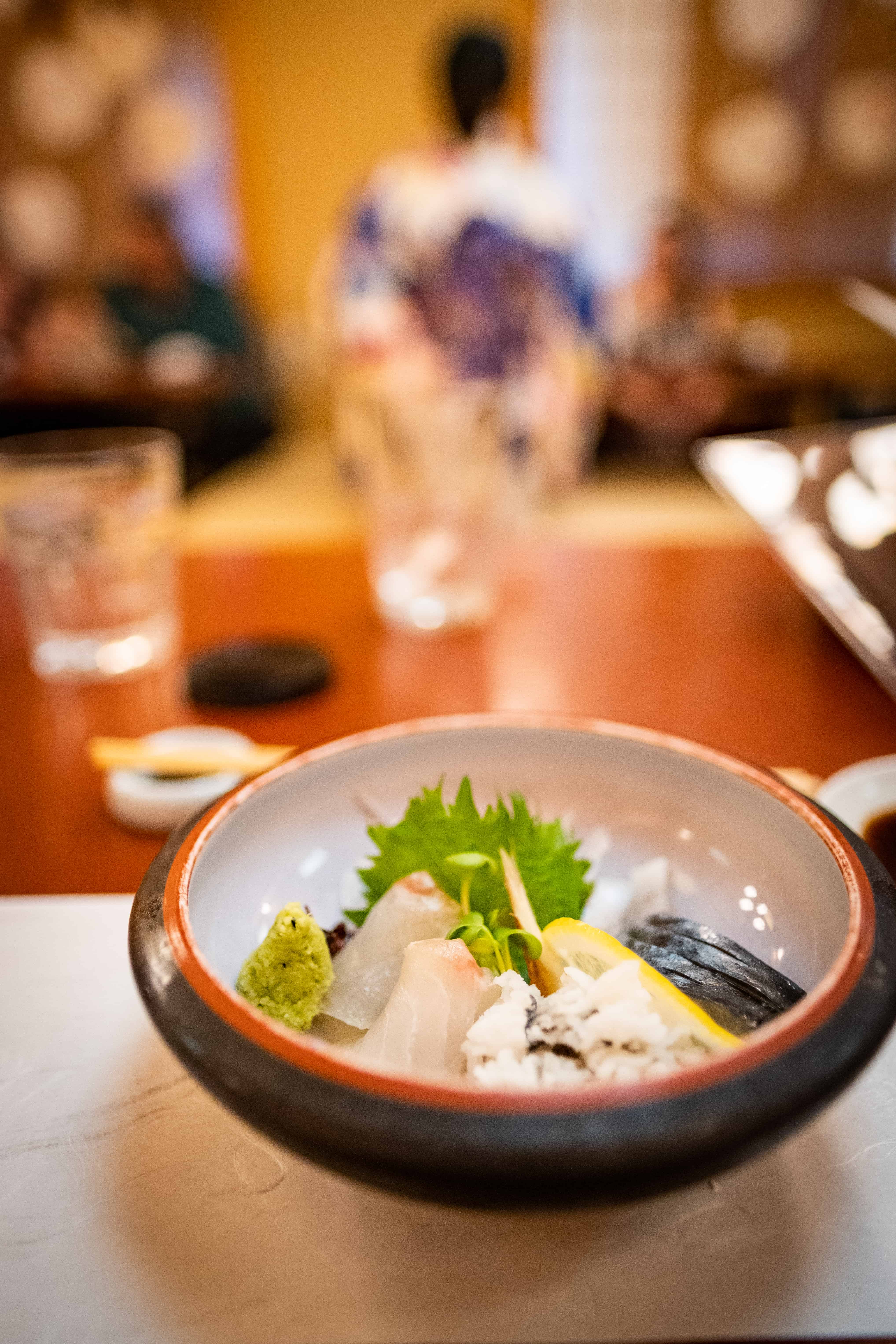
If you love fish, then you must try sashimi. You can typically find sashimi alongside any sushi restaurant. Sashimi is raw fish precisely cut into thin slices and served with wasabi, ginger, and soy sauce – just like nigiri. Sashimi is not served with rice and should always be served fresh. Salmon, tuna, and yellowtail are all examples of fish you will see that are prepared this way.
Approximate Cost: ¥2000
Kaiseki
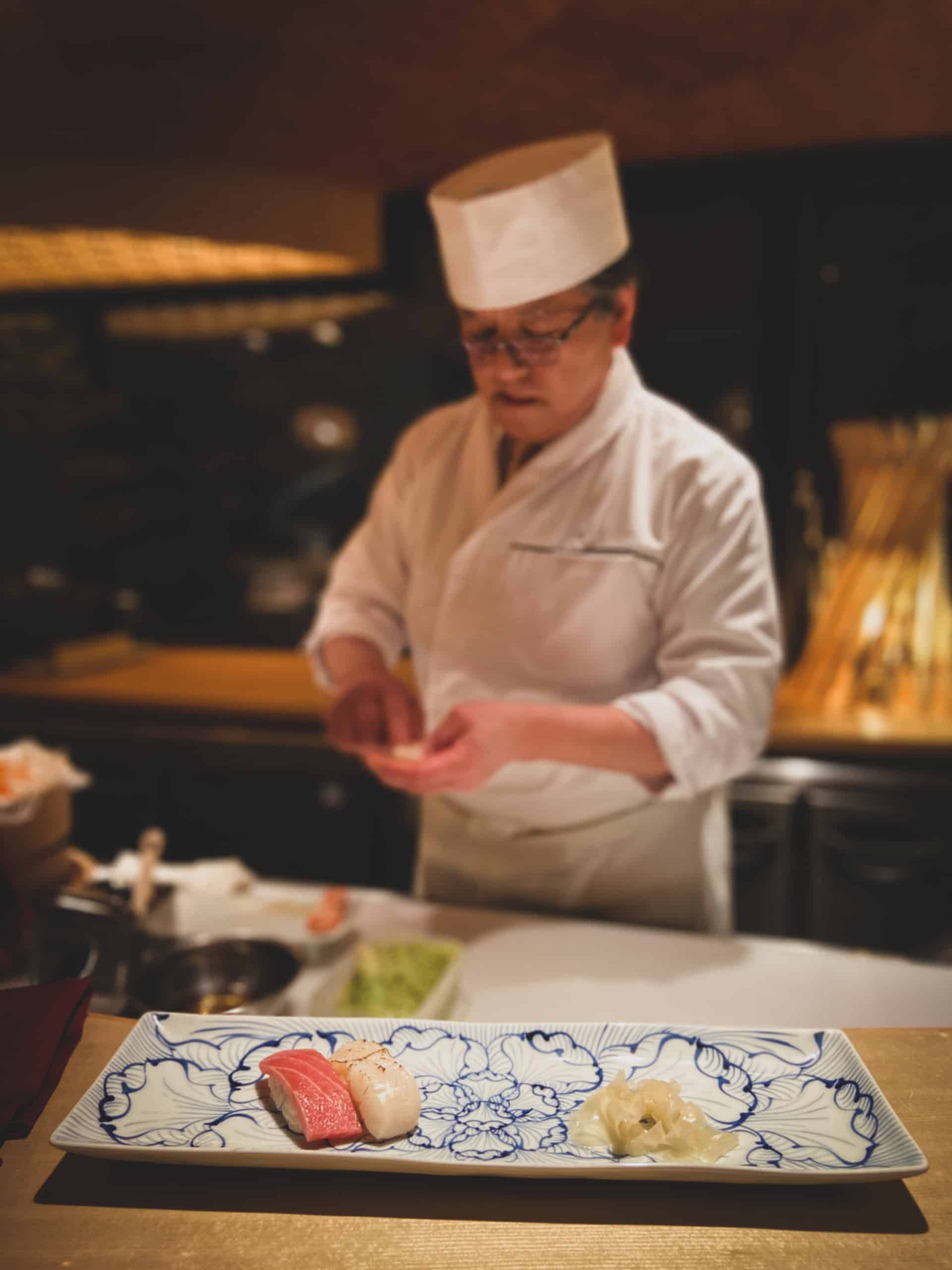
Kaiseki is also referred to as Japanese “Haute” cuisine and having a kaiseki meal can be an exceptional experience. Kaiseki is a multicourse Japanese dinner that can sometimes include more than 12 different Japanese dishes.
Dishes are always varied, local, and prepared in small servings. Kaiseki is not just an average dinner, but rather a whole presentation. You can find Kaiseki meals at ryokans or specialty restaurants. We recently had Kaiseki in Kyoto when we experienced dinner with a Maiko.
Approximate Cost: ¥4000+ pp
Gyoza

Gyoza is moon shaped dumpling you have likely seen before, even outside of Japan. In Japan Gyoza is one of the most popular Japanese foods and is either served as a snack or a side component to your main meal.
Almost all gyoza I have encountered in Japan is filled with pork mince. However, if you are at a specialty shop, you may find vegetarian options. You can also find them in convenience stores or make them yourself at home! Dip them in soy sauce before you chow down!
Approximate Cost: ¥500-700
Tonkatsu

Tonkatsu, a beloved Japanese dish, is made by coating thinly sliced pork with a blend of flour, egg, and breadcrumbs before deep-frying it to achieve a crispy and golden-brown exterior while keeping the inside juicy and tender. Although not the healthiest option, it remains a popular choice among food lovers.
Typically, it is served alongside rice and cabbage, complemented with a sweet and tangy tonkatsu sauce. Additionally, it can be enjoyed as a sandwich, making it a great meal for lunchtime.
Approximate Cost: ¥800-¥1500
Onigiri

Onigiri, also known as omusubi or rice ball, is a traditional Japanese food that is made from steamed white rice that is formed into a triangular or cylindrical shape and is wrapped in nori (dried seaweed). Onigiri can have ingredients like meat, fish, and veggies inside and can be served sweet or savory!
You can find onigiri in almost every convenience store in Japan. It is a simple, portable and convenient food that is often eaten as a snack or a light meal.
Approximate Cost: ¥300-500
Kaki Fry

Kaki Fry, also known as oyster tempura, is a Japanese dish that consists of deep-fried oysters that are coated in a light batter and then deep-fried until golden and crispy. You can find this *healthy* food option at many Japanese seafood restaurants. It’s popular in the colder months, as the oysters are usually in season during this time. We recommend pairing it with a cold Sapporo beer as an appetizer!
Approximate Cost: ¥1000
Fugu

You may have heard of fugu, a type of pufferfish that is highly regarded as a delicacy in Japan and is considered one of the most fascinating Japanese dishes. Fugu is valued for its subtle taste and texture, and indulging in it can be quite costly. However, it can also be potentially hazardous to consume as it contains a lethal neurotoxin called tetrodotoxin, which is present in the fish’s liver, ovaries, and skin.
Because of the dangers associated with fugu, only licensed and trained chefs who have passed a strict exam are permitted to handle and prepare the fish. Additionally, strict guidelines must be adhered to when cleaning and preparing the fish to minimize the risk of poisoning.
Fugu is usually served as thinly sliced raw fish known as sashimi or in a hot pot dish called “fugu nabe.” It can also be enjoyed deep-fried as “fugu kara-age.” Fugu Japanese cuisine is deemed a luxury and can be quite expensive. It is not recommended for individuals with allergies or health issues. Fugu is a Japanese delicacy for those seeking an authentic and unusual dining experience, and who are willing to pay a premium for it.
Approximate Cost: ¥20,000
Oden

Oden is a comforting hot pot dish that’s perfect for cold weather and can be enjoyed year-round. The dish is made by simmering various ingredients like fish cakes, boiled eggs, daikon radish, konjac, and processed fish products in a soy-flavored dashi broth for hours upon hours. All this stewing means the ingredients become tender and absorb the flavors of the broth. It’s best shared and enjoyed for dinner!
Approximate Cost: ¥100 per piece
Yakiniku

Yakiniku is a popular Japanese style of grilling thin slices of meat, usually beef, pork, and chicken. This meat is typically marinated in sauces like soy sauce, garlic, ginger, and sake for a unique and delicious flavor. Diners cook their meat on a small portable grill provided at the table to their liking. Yakiniku often comes with veggies and rice or noodles to make it a complete meal.
Approximate Cost: ¥1500-2500
Yuba
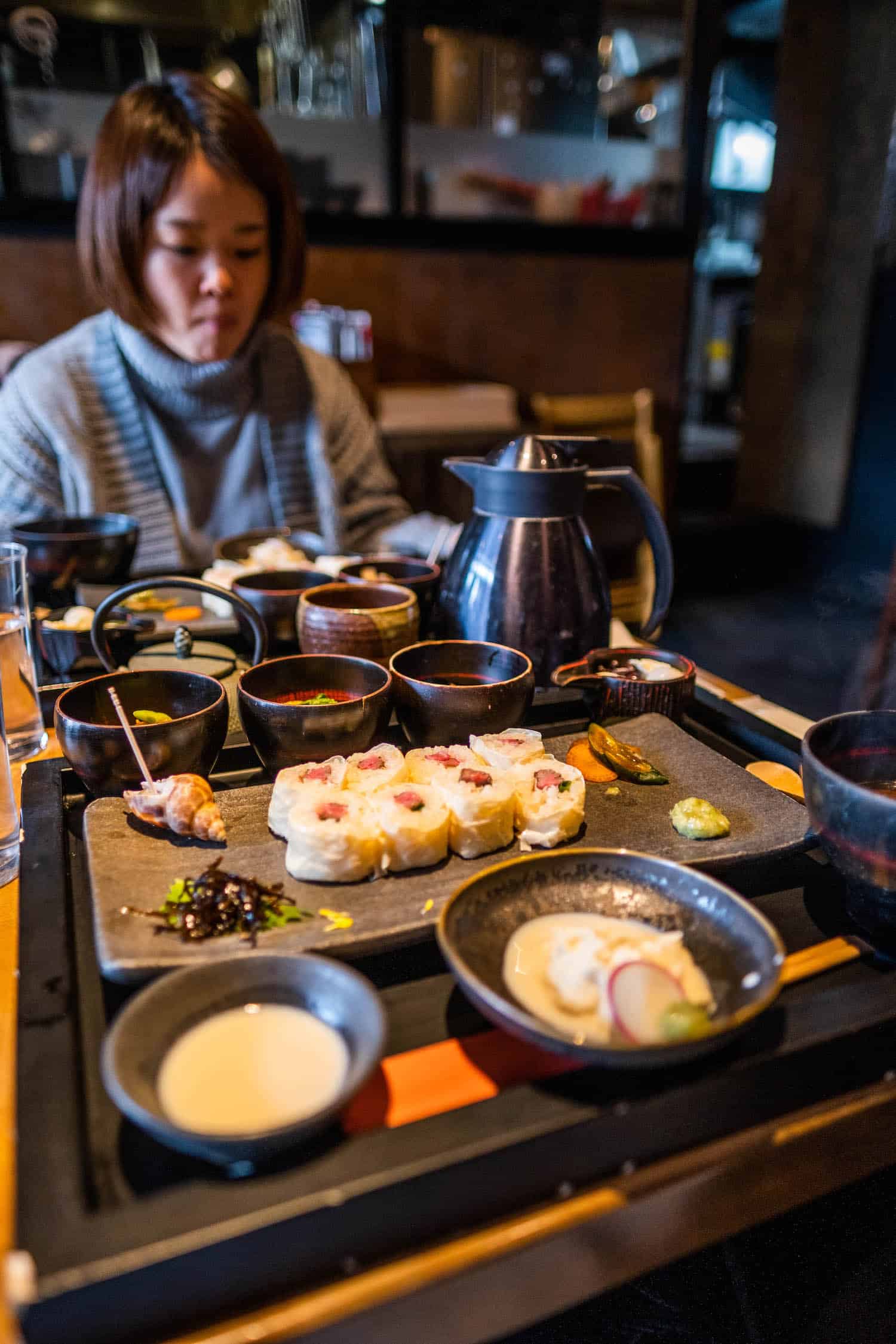
Yuba, also known as “tofu skin” or “soy milk skin,” is a traditional Japanese food made from the thin film that forms on the surface of soy milk when it is heated. It is made by carefully removing the film from the surface of the milk, rolling it up, and then drying it. The resulting product is a delicate, slightly sweet, and creamy-textured food that is rich in protein.
Yuba can be eaten as is, or it can be added to soups, stir-fries, or salads for added texture and flavor. It can also be deep-fried, grilled, or sautéed to make it crispy. Yuba is often used in traditional Japanese cuisine, particularly in Zen Buddhist temple cuisine, where it is considered a healthy and nutritious food. It’s also a great alternative for people who are lactose intolerant or vegan.
Yuba is usually sold dried, but it can also be found fresh in some specialty stores or tofu makers. It’s a versatile ingredient that can be used in many different Japanese dishes and it’s a great way to add a unique texture and flavor to a meal.
Approximate Cost: ¥1000
Bento

Bento is a traditional Japanese meal served in a box or container, convenient for lunch or picnics. It usually includes rice, fish or meat, and vegetables, and the boxes are decorated to be visually appealing. Bento boxes have compartments to separate different Japanese foods to maintain variety of flavors and textures. They can be purchased pre-made or made at home.
Bento boxes are popular for people who want to take lunch to work or school, or for a balanced meal on the go. Traditionally, bento boxes were made with white rice and fish or meat, but there are now options for vegan, gluten-free, and low-carb bento boxes. Some people decorate their boxes with cute designs, known as “kyaraben” or “character bento.”
Approximate Cost: Varies Widely
Edamame

If you’ve gone to any sushi place in the west you’ve likely seen Edamame on the menu. Edamame can also be found in the frozen food section of any grocery store in North America. It’s prevalent in Japan and one of the absolute cheapest vegetables you can find and eat quickly.
If you’ve never had edamame these are immature soybeans that have been harvested before the beans are hardened. In Japan, they are served in the pod, are lightly salted, and accompanied by a side of soy sauce to dip in. They are cheap and can also be found at any convenience store in the frozen section as a quick snack.
Approximate Cost: ¥200-300
Miso Soup

Another staple in any sushi or Japanese restaurant in North America is miso soup. Miso soup is a very common thing to have before any meal in Japan. Miso soup is made from the combination of miso paste and dashi broth. There is typically tofu, wakame seaweed, and green onion in the soup. It’s a delicious light starter to have, especially on a cold day.
Approximate Cost: ¥200-300 per cup
Our Favorite Japanese Drinks
Enough about Japanese foods, let’s discuss what to pair those Japanese dishes with!
Green Tea
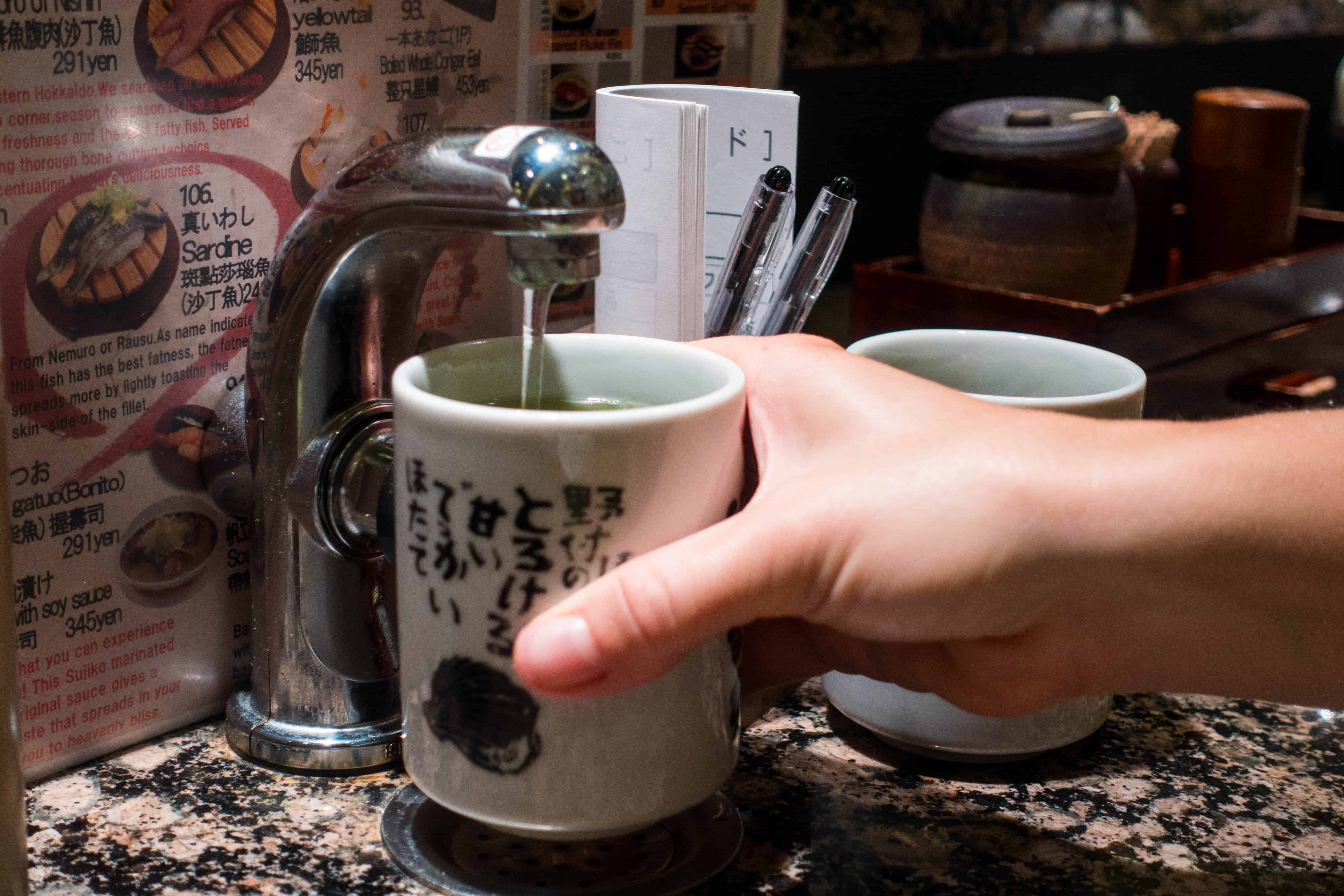
Japan is famous for its high-quality green tea. It’s a traditional Japanese beverage that is enjoyed for its refreshing flavor, health benefits and its cultural significance.
Japanese Beer

If you have ever visited a sushi restaurant outside of Japan, chances are they had Japanese beer on the menu. Japanese beer is obviously popular all over Japan. Some of the most popular brands are Sapporo, Asahi, Kirin, and Suntory! Step into any convenience store and you can’t miss them. Japanese lagers typically have a lower alcohol content than other types of beer, making them a popular choice for casual drinking. You can enjoy beer with any of these Japanese food items!
Shochu
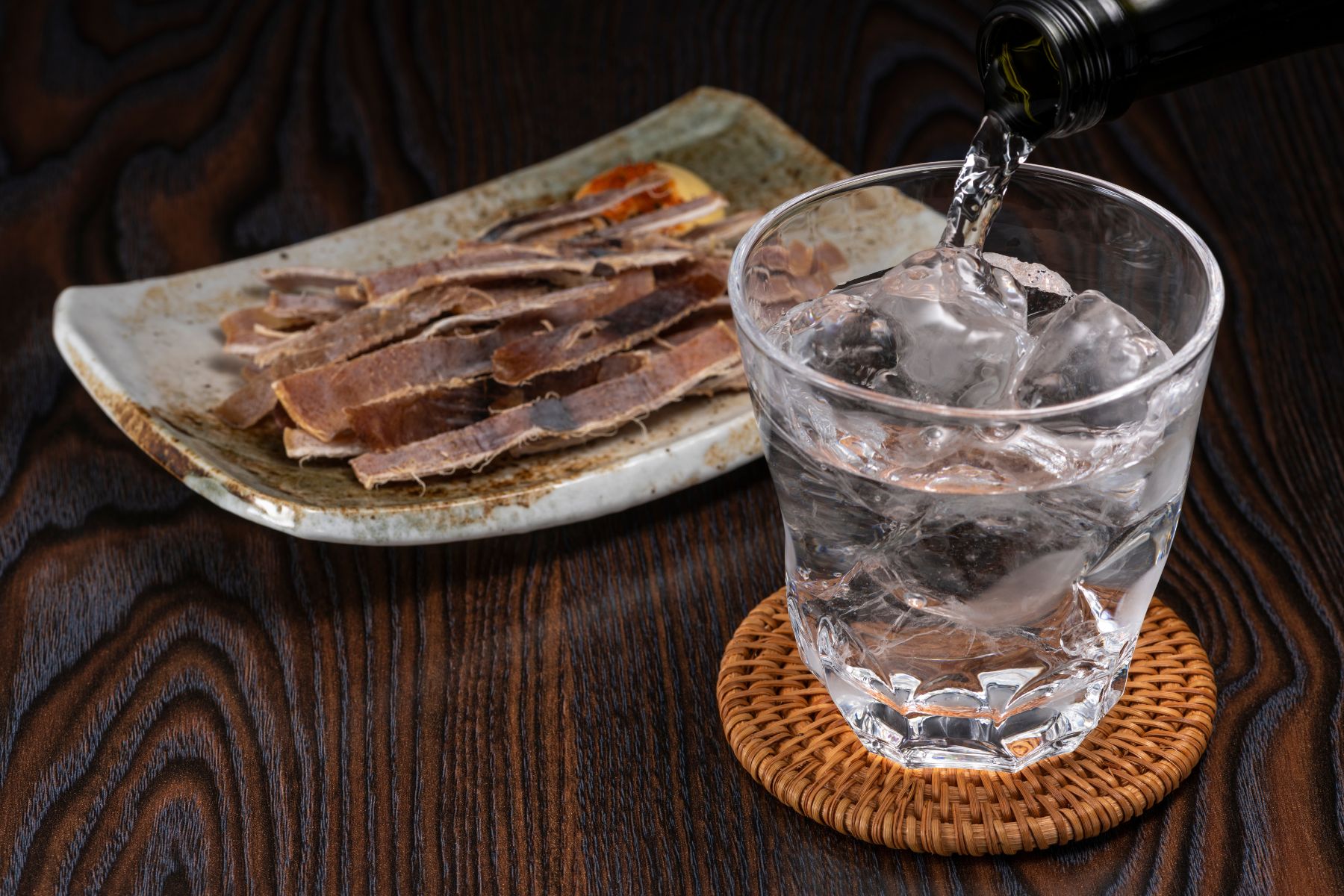
Shochu is a traditional Japanese distilled spirit that is made from things like barley, rice, sweet potatoes, and buckwheat. It is similar to other Asian spirits such as soju from Korea and baijiu from China. Shochu has a distinct and complex flavor, it all depends on the ingredients used, and the distillation process.
For instance, Imo-jochu, made from sweet potatoes, is known for its rich and earthy taste, while kome-jochu, made from rice, has a light and delicate flavor. You can enjoy Shochu neat, on the rocks, or mixed with water (called mizuwari). It’s paired well with other Japanese foods mentioned on this list.
Sake
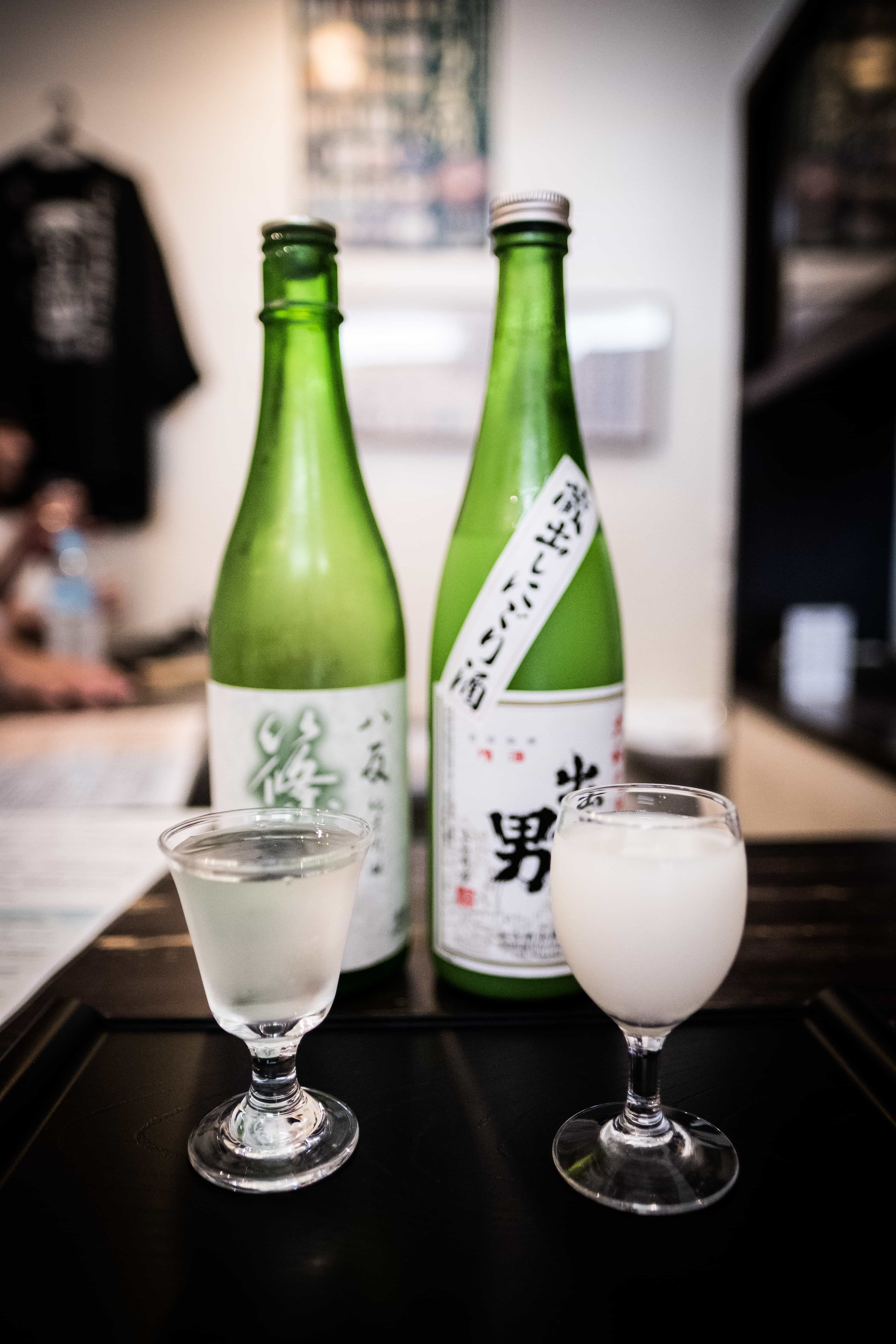

So what drinks go with Japanese food, you ask? Sake is alcoholic Japanese rice wine. It is delicious, and if you have never had it, I urge you to order a carafe, or tokkuri, next time you see it on a menu. Sake is Japan’s national beverage and is often served on special occasions in the tokkuri, a small porcelain bottle, and then poured and sipped from a sakazuki.
You can either have sake chilled, warm, or room temperature. Generally speaking, cheap sake is warmed to mask the taste while fine sakes are slightly chilled to savor the flavor. An average sake is very affordable and can be enjoyed at any one of the fabulous Japanese meals you have out.
We love to have it at an Izakaya (Japanese pub). You can also find it in the liquor section at the grocery store and get yourself a whole bottle for between ¥800-¥2000. Don’t bother trying to pick out the best one by reading the labels; it’s virtually impossible unless you speak Japanese. My best advice is to pick the prettiest bottle and go from there, or you could always test out your language skills and ask someone! Don’t forget to bring some home!
Approximate Cost: ¥500 a glass at a bar, ¥700+ per bottle at the grocery store
Plum Wine (Umeshu)

Umeshu is a Japanese liquor, or plum wine. It’s made from unripe ume fruits, shochu, and sugar. It’s one of the sweetest wines you’ll ever taste, but hot damn it is delicious. There are many types of Umeshu in Japan to try, and you’ll find it on any drinks menu. You can either have your umeshu on the rocks, with sour, with soda water, tap water, or tonic.
My personal favorite is with soda water – it is so refreshing to have after a long day exploring the city. You can have umeshu at room temperature, or hot during the winter months. You can find umeshu at an Izakaya, at the Japanese grocery stores for about 1000 yen a bottle, or you can try making it. That is, if you have ume fruits, sugar, and Shōchū
Approximate Cost: ¥500 per glass at a restaurant. A bottle can be had for ¥1000 at a grocery store.
Our Favorite Japanese Desserts
After all these delicious Japanese foods, you’ll want something sweet!
Matcha

Matcha is a finely ground powder from green tea leaves and an important part of Japan food culture. The finished product is a bright green powder that is commonly used in traditional Japanese tea ceremonies and also in many other food items in Japan. It’s delicious and can be drunk with milk or water – hot or iced. I think Matcha is slightly sweet, vegetal, and nutty – great to have with sushi, poke bowls, or with other sweets.
While matcha is a premium product usually served at hip cafes and vegan restaurants outside of Japan, in the country you can find it everywhere. Matcha ice cream, matcha soba noodles, matcha pancakes, and matcha candy are popular items you may see.
There are also many health benefits of Matcha. It’s packed with antioxidants, boosts your metabolism and enhances the mood, burns calories, and calms the mind. Oh, and it’s green and tastes good. Win win win! If you’re going to try just one Matcha food item – make it the ice cream!
Approximate Cost: ¥200-300 per cone
Yakitate Cheese Tart
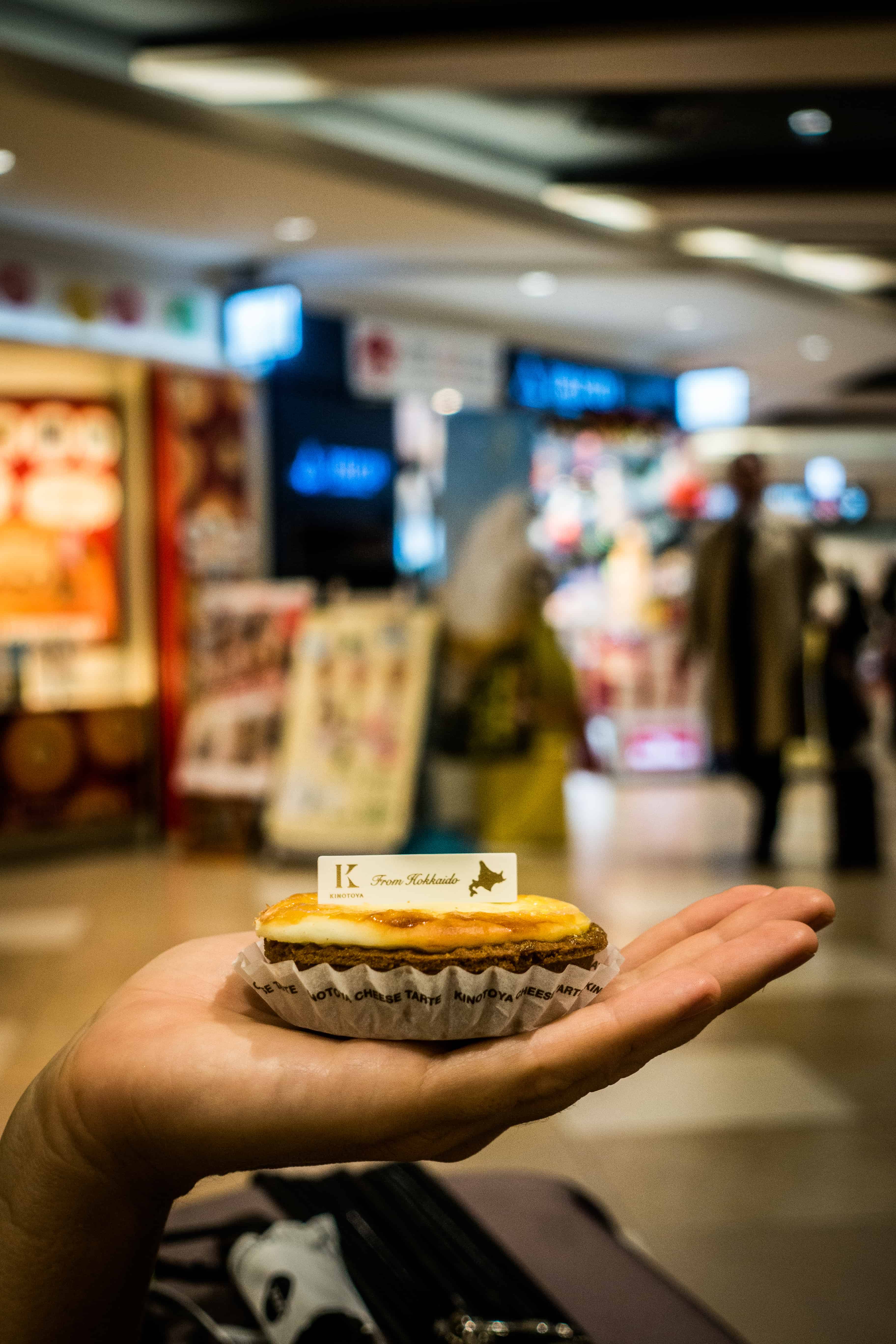
If there is one dessert in the world I would fly half way around the world for it’s the Yakitate cheese tart only found on Hokkaido, it can only be found in Japan. Hokkaido is famous in Japan for their high-quality milk, and that means Cheesecakes in Hokkaido are renowned. They are all delicious, but I found the Yakitate Cheese tart to be the best.
This is a cheesecake baked in the oven after pouring cheese mousse in cookie dough. Then the outside shell is a crispy cookie, with the cheesecake in the center. There’s a shop at New Chitose Airport, so make sure to have one while you’re waiting for your flight. Shops can also be found in Sapporo city center.
Approximate Cost: ¥180 per piece
Mochi

Michi is a Japanese rice cake made out of mochigome, water, sugar, and cornstarch. Mochi is molded into a circle and is eaten year round. It’s a typical dessert snack that can be found at street stalls and convenience stores. There are many flavors of mochi, and some are stuffed with red bean paste!
Approximate Cost: ¥100 per piece
Jiggly Cheesecake
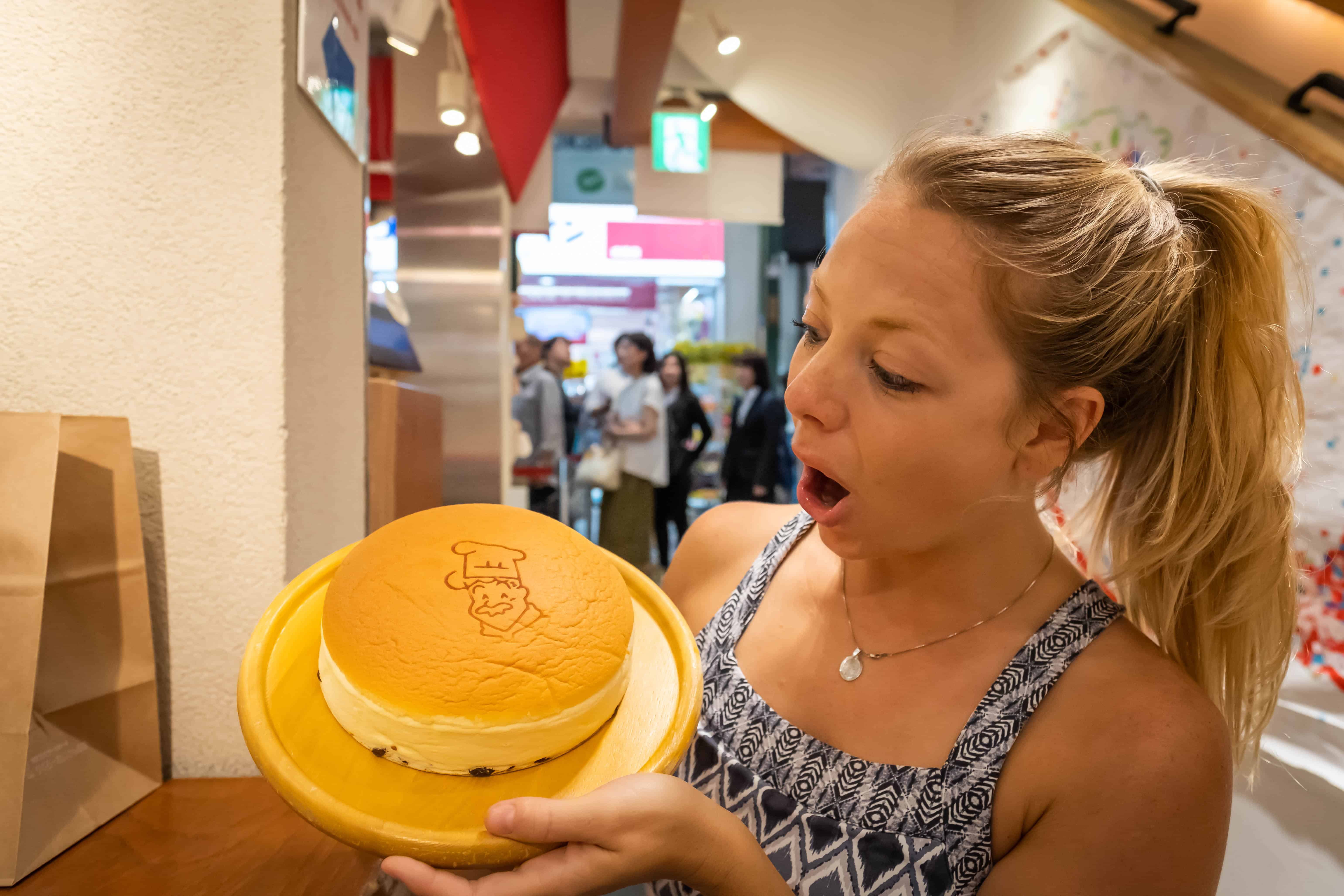
Another famous food to try in Osaka is a Japanese Jiggly Cheesecake. Rikuro Ojisan no Mise is a small shop that sells hot and fresh cheesecakes all day! You can only buy a whole cheesecake, not by the slice here, so come with friends. You’ll likely have to wait in a line to buy a cheesecake fresh out of the oven, but if you prefer not to wait you can also go into the shop and buy one that was made earlier in the day.
We got lucky and only had to wait five minutes or so in the line, but we were told it gets much busier depending on the day. A Jiggly cheesecake will set you back all of ¥700 and it is more than worth it! Plus they keep well if you have a refrigerator in your hotel room.
Approximate Cost: ¥700 per cheesecake
Taiyaki
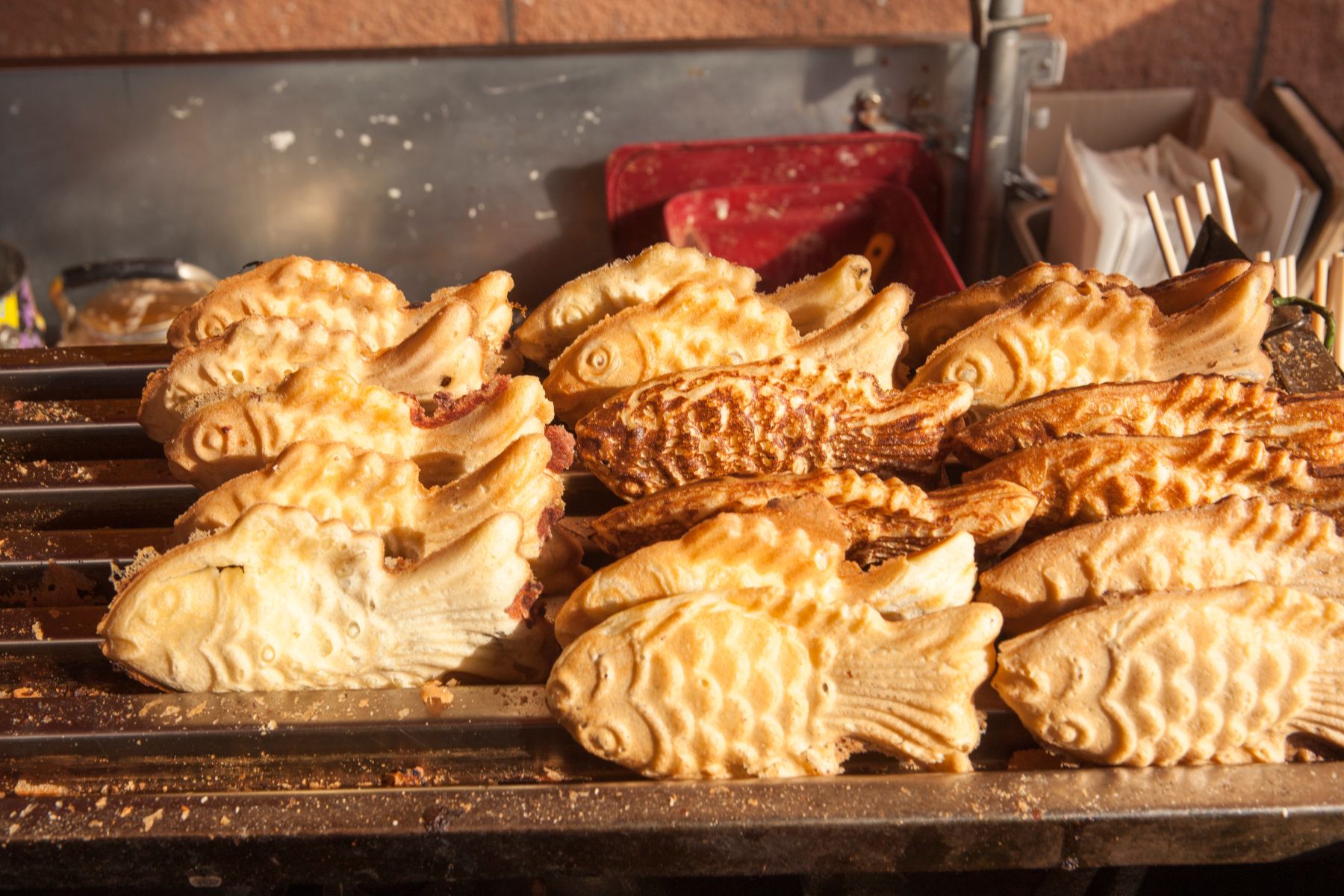
Taiyaki is a traditional Japanese fish-shaped cake filled with sweet red bean paste or custard. I know fish doesn’t quite sound like what you want to hear when you think of a sweet, but hear me out first. The name “taiyaki” literally means “baked sea bream,” as the fish shape of the cake is said to resemble the shape of the sea bream fish. However nothing about the sweet treat tastes like fish, I assure you!
The cake is made from a batter of wheat flour, eggs, sugar, and milk. The batter is poured into a fish-shaped mold, then the filling is added, and the cake is cooked on a griddle until golden brown. Taiyaki is enjoyed warm, in every season. This is a popular street food in Japan, and it is often sold at festivals, fairs, and markets. It is also found in small stands and shops. You can’t miss it as you’re walking around the streets of Japan! Taiyaki can also be filled with other flavors like chocolate, cheese, sweet potato, or matcha. My personal favorite is custard!
Approximate Cost: ¥100-200
When is the Best Time to Travel to Japan?
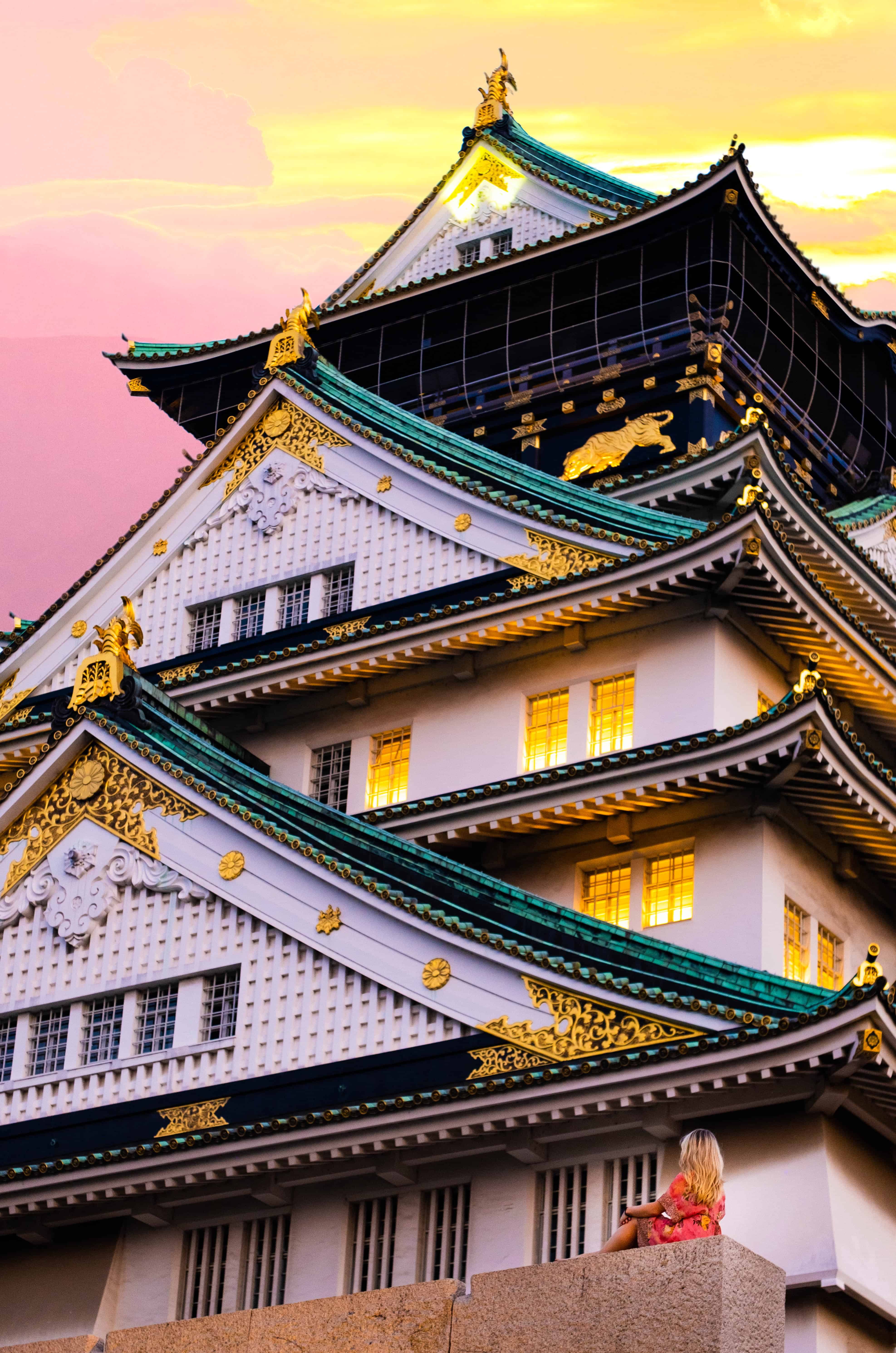
Japan is a four-season country and each winter, spring, fall, and summer brings something beautiful. Determine what you want out of your holiday first and go from there. If you want to be immersed in a winter wonderland, then travel to Hokkaido in the winter for beautiful white powder. If you want to see Sakura (Japanese cherry blossoms) make sure to visit Japan in the spring.
Summer is shoulder season in Japan because June makes the beginning of the rainy season. You’ll find in most places this means hot and humid days, but lower prices. Finally, fall is stunning in Japan. The leaves come alive with many red, orange, and yellow colors, and it’s a fantastic time to travel! You can read more here!
Japan Travel Planning Resources
- Packing Guide—Check out our Japan Packing List to help you pack your bags and ensure you leave nothing at home.
- Protect Your Trip — We don’t travel without travel insurance, nor should you. You never know what can happen while traveling, so it’s best to be prepared. HeyMondo provides excellent short-term and long-term travel insurance plans.
- Travel Adapter – Find a good adapter to keep your electronics charged. Otherwise, you may be paying for a cheap one once you land. Purchase one here.
- Book an Experience – See all the best experiences and tours in Japan here.
- Get a Japan Rail Pass (Buy Here) – They make traveling around Japan much easier and cheaper.
- Travel Shoes – Allbirds are the ultimate travel shoe. They are sustainable and last forever while looking good.
Japan Travel Planning Resources
- Packing Guide — Check out our Japan Packing List to help pack your bags and ensure you don’t leave anything at home.
- Protect Your Trip — Don’t forget to purchase travel insurance! We always carry travel insurance to protect from injury, theft, or a canceled trip. Try HeyMondo for competitive short-term plans. Read a review of HeyMondo here.
- Travel Adapter—Make sure you find a good adapter to charge your personal electronics. Otherwise, you may pay for a cheap one once you land. Purchase one here.
- Book an Experience – See all the best Japanese experiences and tours here.
- Get a Japan Rail Pass (Buy Here) – They make traveling around Japan so much easier and cheaper.


Japanese food is so good, I really love it. However I have yet to do to Japan and try the amazing food locally. Great list to keep when going there 🙂
The food in Japan is half the reason we travel there! 🙂